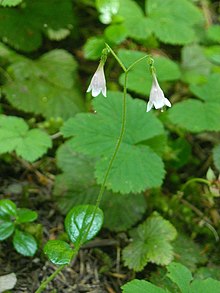
The Caprifoliaceae or honeysuckle family is a clade of dicotyledonous flowering plants consisting of about 860 species, in 33, to 42 genera, with a nearly cosmopolitan distribution. Centres of diversity are found in eastern North America and eastern Asia, while they are absent in tropical and southern Africa.

Devil's club or Devil's walking stick is a large understory shrub native to the rainforests of the Pacific Northwest, but also disjunct on islands in Lake Superior. It is noted for its large palmate leaves and erect, woody stems covered in noxious and irritating spines. It is also known as Alaskan ginseng and similar names, although it is not a true ginseng.

Clintonia is a genus of flowering plants in the lily family Liliaceae. Plants of the genus are distributed across the temperate regions of North America and eastern Asia, in the mesic understory of deciduous or coniferous forests. The genus, first described by Constantine Samuel Rafinesque in 1818, was named for DeWitt Clinton (1769–1828), a naturalist and politician from the U.S. state of New York. For this reason, plants of the genus are commonly known as Clinton's lily. The common name bluebead refer to the distinctive fruit of members of the genus. Since fruit color varies somewhat across species, the common name bead lily is used as well.

A wildflower is a flower that grows in the wild, meaning it was not intentionally seeded or planted. The term implies that the plant is neither a hybrid nor a selected cultivar that is any different from the native plant, even if it is growing where it would not naturally be found. The term can refer to the whole plant, even when not in bloom, and not just the flower.

Linnaea borealis is a species of flowering plant in the family Caprifoliaceae. Until 2013, it was the only species in the genus Linnaea. It is a boreal to subarctic woodland subshrub, commonly known as twinflower.

Asarum caudatum is a plant native to rich moist forests of western North America. It has heart-shaped leaves and a three-lobed purplish flower.

Linnaea is a plant genus in the honeysuckle family Caprifoliaceae. Until 2013, the genus included a single species, Linnaea borealis. In 2013, on the basis of molecular phylogenetic evidence, the genus was expanded to include species formerly placed in Abelia, Diabelia, Dipelta, Kolkwitzia and Vesalea. However, this is rejected by the majority of subsequent scientific literature and flora.

Clintonia uniflora, commonly known as bride's bonnet, queen's cup, or bead lily, is a species of flowering plant in the lily family Liliaceae. The specific epithet uniflora means "one-flowered", a characteristic that distinguishes this species from others in the genus Clintonia. For this reason, it is also known as the single-flowered clintonia.
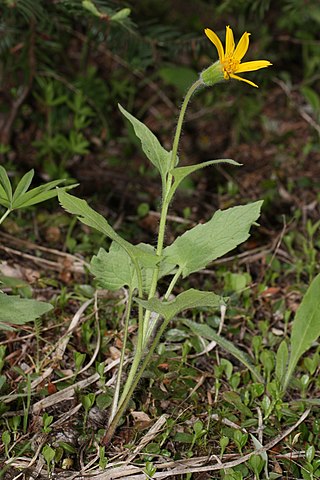
Arnica cordifolia is a species of arnica in the sunflower family, known by the common name heartleaf arnica. It is native to western North America.

Luzula multiflora, the common woodrush or heath wood-rush, is a species of flowering plant in the rush family.
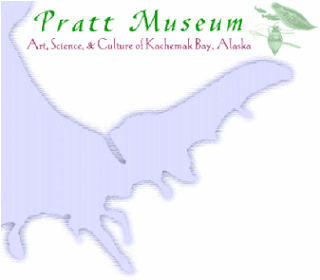
The Pratt Museum is a regional natural history museum located in Homer, Alaska, with exhibits exploring life around Kachemak Bay in South Central Alaska. The museum's mission is to preserve "the stories of the Kachemak Bay region", through "collections, exhibits, and programs in culture, science, and art". Indoor exhibits include early homesteading, Native Alaskan traditions, local contemporary art, and an exploration of the marine and terrestrial life around Kachemak Bay. Outdoor exhibits feature a historic cabin, botanical gardens and a nature trail.

Matanuska-Susitna Valley is an area in Southcentral Alaska south of the Alaska Range about 35 miles (56 km) north of Anchorage, Alaska. It is known for the world record sized cabbages and other vegetables displayed annually in Palmer at the Alaska State Fair. It includes the valleys of the Matanuska, Knik, and Susitna Rivers. 11,000 of Mat-Su Valley residents commute to Anchorage for work . It is the fastest growing region in Alaska and includes the towns of Palmer, Wasilla, Big Lake, Houston, Willow, Sutton, and Talkeetna. The Matanuska-Susitna Valley is primarily the land of the Dena'ina and Ahtna Athabaskan people.

Cypripedium passerinum is a species of lady's slipper orchid known by the common names sparrow's-egg lady's-slipper, spotted lady's-slipper, and Franklin's lady's-slipper.
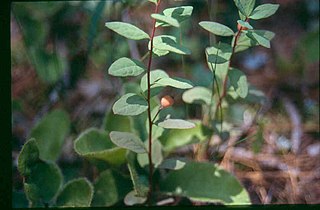
Geocaulon is a monotypic genus of flowering plants in the family Santalaceae containing the single species Geocaulon lividum, which is known by the common names northern comandra and false toadflax. It is native to northern North America, where it is common and widespread from Alaska to Newfoundland and into the northernmost contiguous United States.
The North American Native Plant Society (NANPS) is a volunteer-operated registered charitable organization concerned with conserving native plants in wild areas and restoring indigenous flora to developed areas. It is noted for its work in educating business and the public about the benefits of using native plants, and its work in promoting native species through plant sales and seed exchanges has been credited with the resurgence of some species. It also maintains a list of local native plant societies across the United States and Canada.
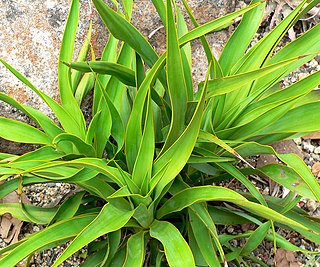
Yucca rupicola is a plant in the family Asparagaceae, known as the twistleaf yucca, twisted-leaf yucca, Texas yucca or twisted-leaf Spanish-dagger. The species was described by George Heinrich Adolf Scheele in 1850. This is a small, acaulescent plant with distinctive twisted leaves. It is native to the Edwards Plateau region of Texas and also to northeastern Mexico.

Dyschoriste oblongifolia is a species of the genus Dyschoriste, in the family Acanthaceae. Dyschoriste oblongifolia is also called oblongleaf snakeherb or twinflower.
Bistorta plumosa is a flowering plant species in the family Polygonaceae, or buckwheat family. Common names for Bistorta Plumosa include meadow bistort. Bistorta plumosa is monoecious, with flowers containing both male and female reproductive parts that are pollinated by insects. Birstorta plumosa flowers annually in the summer months from May to June and can be found in habitats ranging from moist to dry sites and tundra in North America, Alaska, Yukon, the Northwest Territory, and East Asia.

Verna E. Pratt was an American botanist, gardening expert, and author. She was considered an expert on Alaska native plants and wildflowers and produced several field guides on the topic. Pratt is also credited for popularizing the knowledge of Alaska plants among gardeners and recreationalists.


